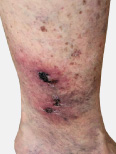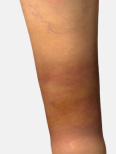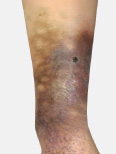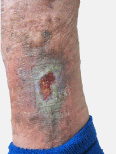
Complications of Untreated Varicose Veins
Veins are “pipes” that are responsible for returning blood to the heart. Varicose Veins are damaged, swollen, enlarged veins that do not work properly allowing blood to pool in legs.
Veins in the legs are far from the heart and must work against the force of gravity to pump blood back towards the heart. Heredity is a common risk factor making veins prone to weakness and failure. Other risk factors include age, pregnancies, prolonged sitting or standing, and history of trauma or clots in legs.
Complications of Untreated Varicose Veins
-

Blood Clot
Compromised blood flow and inflammation can cause superficial thrombophlebitis. Patients may experience redness of the skin, increased tenderness and swelling. -

Spontaneous Bleeding
Varicose veins cause increased pressure of blood in the veins and fragile skin over time. Terminal branches of veins are pushed closer to the skin surface. This is a perfect setup for spontaneous bleeding. Even a slight scratch can lead to profuse bleeding that is usually painless. Patients may lose a significant amount of blood very quickly. -

Hyperpigmentation
Left untreated, varicose veins cause increased pressure of pooled blood in leg veins. Fluid leaks out of these veins and may result in painful swelling and discoloration of skin known as hyperpigmentation. Inflammation of skin may cause severe itching, burning and redness. -

Lipodermatosclerosis
Continued inflammation of the skin over time causes the skin to become firm and leathery. Patients feel increased tenderness of the skin. The stiffening and hardening of the skin is known as Lipodermatosclerosis. -

Venous Leg Ulcer
Long-standing venous hypertension causes damage to the skin which eventually breaks down to form an ulcer. These ulcers do not heal well and may cause itching, bleeding and infection. In rare cases, infection could lead to serious conditions such as osteomyelitis (infection of the bone) or sepsis (blood poisoning).
Varicose veins are typically located deep inside the leg and may not be visible from the outside. Initially, the symptoms include leg pain, tiredness, heaviness, itching, throbbing, or burning sensation in the legs. These symptoms are usually worse at the end of the day after a person has been sitting or standing for long periods of time and are usually better upon first getting out of bed. The recurrent increased pressure of blood in leg veins allows leakage which can cause swelling in the legs. The build-up of deoxygenated toxin-rich blood in muscles makes them prone to cramping and restlessness in legs. There is a higher risk of clot formation and bleeding that can be profuse.
Continued increased pressure of blood in the leg veins causes changes to the skin that are typically noticed in the mid-calf to the ankle area. This condition, known as stasis dermatitis, is characterized by severe itching and redness of the skin followed by hyperpigmentation (discoloration of the skin due to deposition of iron pigments). This is followed by induration (thickening of the skin) and dermal fibrosis (scar tissue): a condition known as Lipodermatosclerosis. There may be atrophie blanche (smooth, ivory-white plaques surrounded by hyperpigmentation). The final stages of chronic venous insufficiency are related to the breakdown of skin and the formation of poorly healing leg ulcers (sores). There is a higher risk of local skin infection (cellulitis), sepsis (blood poisoning), and osteomyelitis (infection of the bone).
Over the past few decades, extensive research has allowed us a much better understanding of the causes of leg ulcers. We now know that majority of ulcers in the legs are venous (varicose veins). Venous leg ulcers account for about 80% of all leg ulcers. These ulcers are typically painless unless there is an infection on top of the leg ulcer or physical irritation that can cause pain. Fortunately, we also have technology such as laser (Endovenous Laser Ablation) that allow us to treat the underlying problem at its source in a minimally invasive manner.
Vein treatments are safe, effective, virtually painless, and do not require any downtime. Your Vein Specialist at Alsara Vein Clinic has performed over 25,000 treatments and helped countless patients some of whom came with prior failed treatments or no hope that anything could be done. Call for a Consultation at 816-396-0245.
Clinical Notes:
Dona is an "active" female who came to us in a wheelchair. She has lived with ulcers in both of her legs for several years. She has received wound care for numerous years without long-term relief; ulcers and skin infections became recurrent problems for her. She has also lived with substantial leg swelling, leg cramps and extreme sensitivity to touch. She has restless leg syndrome and was prescribed medications, such as Requip. Still, the discomfort in her legs (at night) remained.
She received endovenous laser ablation of the "leaky" (refluxing) axial veins in both legs at Alsara Vein Clinic in Spring 2018. By the start of Summer 2018, the ulcers in her legs had completely healed. The swelling is almost nonexistent and, for the first time in several years, she can enjoy pain-free legs both during the day and at night.
Another Smile Restored!
 What made you choose us?
What made you choose us?- A nurse practitioner's recommendation.
- What symptoms were you experiencing?
- Swelling in lower legs, wounds that would not heal.
- How were you affected by your legs previously?
- Legs had been swollen for years, couldn’t walk much; skin so tight I couldn’t move knees or ankles.
- What has changed after treatment?
- Swelling & sores gone, wounds healed, able to bend knees & flex ankles – walking better.
- Additional Comments: What did you appreciate?
- Everyone at Alsara Vein Clinic put us at ease from the start, very helpful. We loved the casual professionalism and witty banter because we knew/felt deep down you really wanted to help.
- What makes us different than other medical clinics?
- No stuffy robotic atmosphere. You treated us like people, not numbers.

